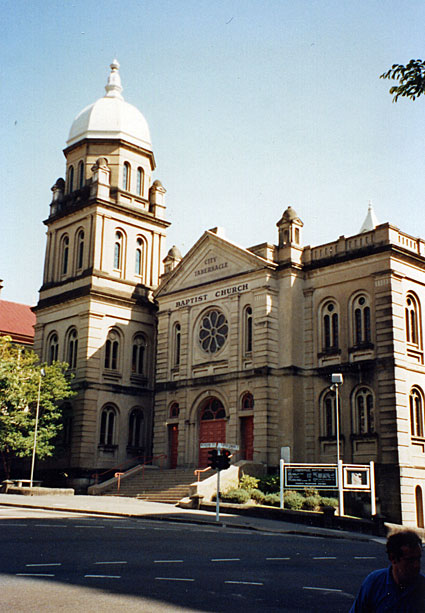
City Tabernacle Baptist Church, Brisbane
[Photograph by Howard Baker (1990s)]

City Tabernacle Baptist Church, Brisbane
[Photograph by Howard Baker (1990s)]
Historical and Technical Documentation by Geoffrey Cox
© OHTA 2012, 2014, 2015 (last updated August 2015)
Upon arrival on the ship 'Fortitude' in 1849, the earliest Baptists in Brisbane banded together with Presbyterians and Congregationalists to form the 'United Evangelical Church of Brisbane'.1 They met at first in the old Court House, Queen Street, but soon established a little meeting house of their own in William Street.2
The experiment in ecumenism did not last, however, and the three denominations soon established themselves independently. With the arrival of further Baptists from Sydney in 1855, they constituted themselves to form a distinctively Baptist congregation. Baptist services were held at first in the Exchange Room of the Police Court, but in 1858 they commenced building the Wharf Street Baptist Church, which was opened on 6 February 1859.3
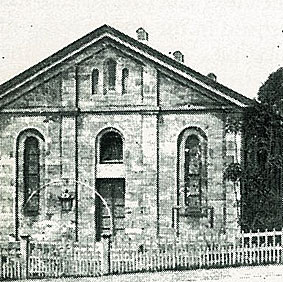
Wharf Street Baptist Church, Brisbane
[Photograph from City Tabernacle Baptist Church
… Centenary (1990), p. 4]
The Wharf Street church was enlarged in 1881, but it remained too small for the congregation. The site was eventually sold in 1888.4 The final Sunday service there was held on Sunday 5 October 1890, at which time the organist was Mr E. Dingle.5
The present City Tabernacle Baptist Church on Wickham Terrace was designed in the 'classic Venetian style' by the Irish-born architect Richard Gailey (1834-1924), who had settled in Brisbane in 1864. Gailey was a devout Baptist, and the City Tabernacle has been described as his grandest monument.6 The new building was dedicated on Thursday 9 October 1890,7 and the first service was held there on Sunday 12 October.8
First Organ.
The first organ in the City Tabernacle Baptist Church had been supplied by Hill & Son of London in 1877 for the Wharf Street Baptist Church. The order for the instrument was apparently placed with some sense of urgency: The records of the firm list it as Job No 1653 for 'Shaw & Co Brisbane' and the entry in the Shop (Order) Book, dated 1877, is marked 'immediate':9
1653 Shaw & Co Brisbane Immediate Gt Org CC to G - Old organ from Holywell
Sw ten C - old 1638
Ped [F?] Gedact Bdn
|
There are two earlier entries in the Shop Book to which this one appears related: First, the reference to Job No 1638 above refers to an earlier entry [dated 1876] for 'Mr J. Ashton, Didsbury', which includes reference to a new swell box, and a penciled cross-reference to Job 1653. Secondly, the reference to 'Old organ from Holywell' appears to be related to an entry in the same Shop Book for Holywell Church [St Cross, Oxford], marked Job No 1622 and dated Easter 1877, which includes reference to the re-use of 'pipes from old organ'.10 It appears, therefore, that the organ for the Wharf Street Baptist Church was completed with some urgency, and that it used secondhand pipework from more than one source.
The Hill & Son organ was installed in the Wharf Street church in 1878, and it was transferred to the new City Tabernacle Baptist Church on Wickham Terrace in 1890.11 Further surviving details of the Hill & Son organ appear in a feature article dealing with Brisbane organs in March 1906, as follows:
BAPTIST TABERNACLE ORGAN
The organ at the Baptist Tabernacle was built by Hill and Son, London, and was one of the first pipe organs erected in Brisbane. At the time of its erection it cost about £400. There is nothing elaborate about the instrument, but the tone is good. It contains nine sets of pipes: 4 on swell organ; 4 on great organ; and 1 on pedal organ. The couplers are great to pedal, and swell to great. A short time ago the organ was thoroughly cleaned and tuned. There is some talk of a new instrument being procured for this church. The organist and choirmaster is Mr. H. L. Newman.12
This account is accompanied by a photograph the organ:

The 1877 Hill & Son organ in the City Tabernacle
[Photograph: The Daily Mail (10 March 1906), p. 13]
Based on the above accounts, the specification of the 1877 Hill & Son organ can be reconstructed as follows:
| GREAT Open Diapason Dulciana Stopped Diapason Principal SWELL Cone Gamba Gedackt Principal Oboe PEDAL Bourdon COUPLERS Great to Pedal Swell to Great |
8 8 8 4 8 8 4 8 16 |
[Ten.C] |
Mechanical action
2 compositions pedals
Compass: 56/44/30
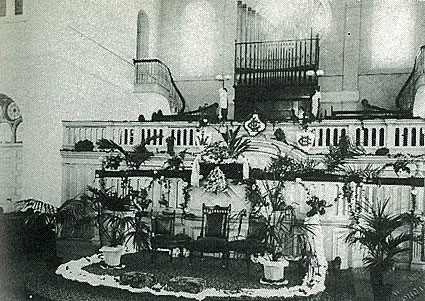
The 1877 Hill & Son organ in the sanctuary
of the City Tabernacle, 25 June 1895
[Photograph from City Tabernacle Baptist Church
… Centenary (1990), p. 25, and church vestry.]
The Hill organ continued to serve at the City Tabernacle until it was replaced by the present instrument in 1914-15. It was sold in August 1914 to the Rev. W.K.W. Stephenson, 'acting for principals in Sydney.'13 Its fate remained a mystery for many years, but it can now be identified as the organ installed around this time at St Andrew's Anglican Church, Roseville, NSW. The latter was broken up in 1953 and the pipework incorporated into a new instrument by S.T. Noad.14
Present Organ.
Plans to replace the old Hill organ had commenced as early as 1888. An proposal was received from the organbuilder Mr W.G. Rendall of Sydney in 1901, and consideration was given in 1911 to purchasing the T.C. Lewis organ from St Luke's Anglican Church, Charlotte Street.15
In February 1914 an order was finally placed with Messrs B.B. Whitehouse & Co. of Brisbane for an organ that would include such modern features as a crescendo pedal (possibly the first of its kind in Australia) and a stop-key console to be placed some 10ft from the organ itself:
. . . an order has been given to Messrs. B.B. Whitehouse and Co. for an instrument to cost something more than the minimum stated. The instrument has been designed by Mr. Whitehouse, and will contain three manuals and a pedal organ, besides many other features of interest. There will be six stops on the great organ, seven on the swell, four on the choir, and three on the pedal. The manuals will extend to C in alt., that is, three semi-tones higher than in the older organs; and the stops chosen will afford plenty of scope for tone colouring, especially when used in combination by means of the various couplers. The usual accessories, such as pistons to obtain combination of tone, balanced swell pedal, &c, will be used; also a pedal for obtaining crescendo and diminuendo effects, by the addition or subtraction of stops. This is quite a new feature, and will probably be the first of its kind in Australia. Several other modern appliances will be used, such as key stops instead of organ draw stops, a radiating and concave pedal board, &c. The organ will be blown by an electric motor, and will be played from a console about 10ft. distant from the front pipes, so as to enable the organist to mass the choir in front of him.16
The opening recital was given on Wednesday 27 January 1915 by Mr Percy Brier, the church organist:
NEW PIPE ORGAN AT THE CITY TABERNACLE
The new pipe organ at the City Tabernacle which has been installed at a cost of £1200, will be available for use this week. During the visit of the Rev J. Mussell to England early last year a promise was obtained from the Carnegie Trust that a grant of £500 would be made towards the cost of the organ, provided the cost was not less than £1000 and that the remainder of the sum required was raised by those interested. The matter was very cordially taken in hand by the church officers and members, about the middle of last year and now the required sum is in hand though some extras have still to be provided. The organ, which has been built by Messrs B.B. Whitehouse and Co. of Brisbane, is understood to be one of the largest yet constructed by any Australian builder, and is claimed to be the largest yet built in Queensland. In the specifications everything was made subservient to the quality of the organ as a musical instrument. The organ will be used for the first time this evening, when the church organist Mr Percy Brier, A.R.C.O., will give a recital, and the selections will be interspersed with items by a large choir. The dedication of the instrument will take place next Sunday.
The specification of the organ is as follows -
Great organ, CC to C. (61 notes). - 1. Open diapason (large), 8ft. metal, 61 pipes; 2. Open diapason (small), 8ft. metal, 61 pipes; 3. Hohl flote, 8ft. wood 61 pipes; 4. Dulciana, 8ft. metal, 61 pipes; 5. Principal, 4ft. metal, 61 pipes; 6. Harmonic claribel flute, 4ft. wood, 61 pipes.
Swell organ, CC to C. (61 notes). – 7. Open diapason, 8ft. metal, 61 pipes (open pipes throughout); 8. Rohr flote, 8ft. wood-metal, 61 pipes; 9. Viola de Gamba, 8ft. metal, 61 pipes; 10. Voix celeste, 8ft. metal, 49 pipes; 11. Geigen principal, 4ft. metal, 61 pipes; 12. Horn, 8ft. metal, 61 pipes (harmonic treble); 13. Hautboy, 8ft. metal, 61 pipes.
Choir organ, CC to C. (61 notes). - 14. Stop diapason, 8ft. wood or metal, 61 pipes; 15. Salicional, 8ft. metal, 61 pipes; 16. Flauto traverso, 4ft. metal, 61 pipes; 17. Clarionet 8ft. metal, 61 pipes.
Pedal Organ, CCC to F. (30 notes). - 18. Open diapason, 16ft. wood, 30 pipes; 19. Bourdon, 16ft. wood, 30 pipes; 20. Bass flute, 8ft. wood, 30 pipes.
Couplers. - Swell to great, swell to pedal, great to pedal, choir to great, swell to choir, choir to pedal, swell super octave, swell sub octave, great super octave, pedal octave.
Accessories. - 3 pistons to great organ with release. 3 pistons to swell organ with release. 3 pistons to pedal organ with release. 2 pistons to choir organ with release. 1 reversible piston for great to pedal coupler with release. 1 reversible piston for swell to great coupler with release. 1 stop key for connecting pedal pistons with great pistons. Balanced swell pedal. Balanced pedal for crescendo and diminuendo. Tremulant to swell.
The action to keys, pedals, drawstops and couplers is the builders' special form of tubular pneumatic with a separate pallet to every pipe. This prevents robbing, insuring perfect speech and repetition, whether the manuals are used singly or coupled. The instrument is blown by a rotary blower driven by an electric motor. The latest system of stop keys has been used. The pedal board is of the revised Royal College of Organists pattern (radiating and concave), and of well seasoned walnut, dull polished. The pistons are fitted with pneumatic release, and the keys may be arranged by the player independently of the pistons. The soundboards are of ample size, made of thoroughly seasoned timber, and painted to resist damp. Both drawstop and pallets are entirely pneumatic. The soundboards are slideless. The bellows are of ample size to insure a copious and steady supply of wind to the pipes, and are double-leathered throughout, and fitted with panels which, when removed, render every portion of the interior easy of access. The swell box is lofty and of suitable thickness, stuffed and lined inside with patent sound-proof lining, and painted outside and made perfectly tight. The shutters (fitted vertically) are padded, and every precaution has been taken to insure an effectual and silent closing. The case work is or pine, design neat but plain, and stained and wax polished. The front pipes are of carefully selected stout zinc, silvered with aluminium. The interior pipes are of the best plain metal, with trebles of spotted metal to small-scale stops, and basses of zinc of suitable thickness. The diapasons are made of specially thick metal. The wood pipes are made of thoroughly seasoned timber with hardwood facings, and constructed on the most improved principle. The trebles are varnished to resist damp. The voicing of the pipes is such as to secure power and accurate balance of tone in full combination together with purity and delicacy in the soft and solo registers. The scaling of the pipes was specially adapted to the size and requirements of the building, and was carried out under the personal supervision of Mr. J. H. Whitehouse. The pitch is French Diapason normal. This is the only organ [in] Queensland tuned to this pitch, and is the same as that used by Madame Melba.17
The dedication of the organ took place on the following Sunday, 31 January, when the Hallelujah Chorus was sung both morning and evening. The anthem in the morning, 'And the glory', was also from The Messiah. In the evening, the choir sang the Gloria from Mozart's Twelfth Mass, and 'Send Out Thy Light' by Gounod.18
The original specification of the organ, according to the above account, comprised 3 manuals, 20 speaking stops, 10 couplers and tubular-pneumatic action. The instrument was roughly contemporary with two of the firm's most notable tubular-pneumatic organs of similar size: for St Brigid's, Red Hill (August 1914; 17 stops) and St Mary's, Ipswich (October 1915; 19 stops). This was the largest organ that the Whitehouse firm had built by that time, and the first with 3 manuals.
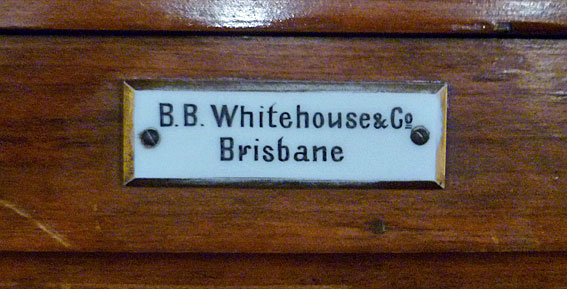
The builder's nameplate
[Photograph by David Vann (April 2014)]
The only major addition to the organ in its early years was a Contra Gamba 16ft, added to the Swell in 1924 at a cost of £195 and doubling as a Violone 16ft on the Pedal. The new Contra Gamba stop was presented to the church by Mrs Frances Lethem in memory of her late husband and daughter.19
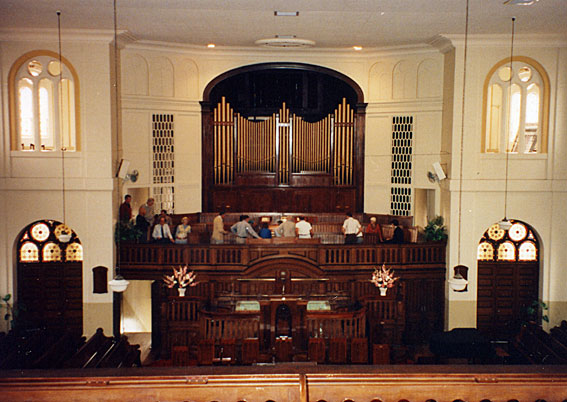
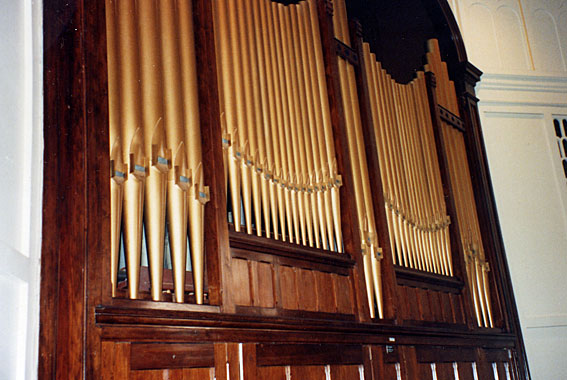
The 1915 B.B. Whitehouse & Co. organ
in the City Tabernacle Baptist Church
[Photographs by Howard Baker (1990s)]
With two Open Diapasons on the Great and no stops above 4ft pitch, the specification showed a greater emphasis on foundation tone than at Red Hill or Ipswich:
| GREAT Open Diapason No. 1 Open Diapason No. 2 Hohl Flote Dulciana Principal Harmonic Claribel Flute SWELL Contra Gamba Open Diapason Rohr Flote Viola da Gamba Vox Celeste Geigen Principal Horn Hautboy CHOIR Stop Diapason Salicional Flauto Traverso Clarionet PEDAL Open Diapason Bourdon Violone Bass Flute COUPLERS Great to Pedal Swell to Pedal Choir to Pedal Swell to Great Swell to Choir Choir to Great Swell Super Octave Swell Sub Octave |
8 8 8 8 4 4 16 8 8 8 8 4 8 8 8 8 4 8 16 16 16 8 |
A A |
[1924] [1924] |
Swell tremulant
Tubular-pneumatic action
Detached stop-key console
Pedalboard: radiating & concave
Crescendo Pedal (including Great Octave coupler, operable only by this means)
Compass: 61/30
Balanced Swell Pedal
Balanced Choir Pedal
3 thumb pistons (& cancel) to Swell Organ
3 thumb pistons (& cancel) to Great Organ
2 thumb pistons (& cancel) to Choir Organ
3 thumb pistons (& cancel) to Pedal Organ (located under the Choir manual)
1 Swell to Great thumb piston
1 Great to Pedal thumb piston
Great pistons to Pedal pistons.20
The organ survived without major alteration for several decades. Minor work included 'removing console' and 'alterations to choir organ' in 1927, retubing the console in 1936, replacing the blower cover in 1939, a general overhaul in 1952 and general reconditioning in 1954.21
At the instigation of the organist, Mr Will Stay, a programme of enlarging the organ was commenced in the early 1960s: Five stops (Lieblich Gedact 8ft, Vox Angelica 8ft, Concert Flute 4ft, Piccolo 2ft & Orchestral Oboe 8ft) were added to the Swell organ around 1962 and a further two (Vox Humana 8ft & Corno di Bassetto 8ft) in 1970. These were all placed in a secondary swell box above the existing one, both sets of shutters being operated by the same pedal. The crescendo pedal was removed in 1970,22 and the Swell Viola da Gamba 8ft and Choir Salicional 8ft appear to have been swapped at some time during this period. By the early 1970s, the organ had 29 speaking stops and 9 couplers, and retained its tubular-pneumatic action.23
The instrument was rebuilt with electro-pneumatic action in 1985-86 by H.W. Jarrott of Brisbane, who provided a new 3-manual draw-stop console and expanded the pedal compass to 32 notes. The secondary swell division was re-deployed as a floating Solo division, able to be coupled to any of the manuals or to the pedals. Additional stops were provided by Jarrott in 1989.24
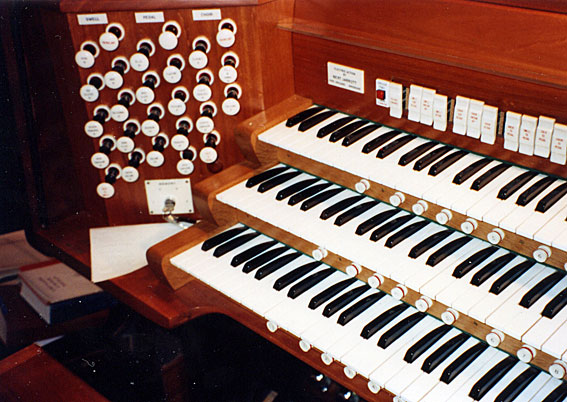
New console provided by H.W. Jarrott in 1986
[Photograph by Howard Baker (1990s)]
Around 2000, a programme of rebuilding and enlargement by Ian D. Brown & Associates of Ballina was commenced. In the first stage, a Trumpet 8ft stop was added to the Great in 2000,25 and this was extended in 2003 to provide a Trombone 16ft and Contra-Trombone 32ft on the Pedal Organ.26 The bottom octave of the Contra-Trombone is electronic, employing a 15-inch sub-woofer supplied by Peterson Electro-Musical Products of Alsip, Illinois, USA.27

Trombone 16ft pipes added in 2003
[Photograph by David Vann (April 2014)]
In 2011, the second stage commenced with further cleaning and tonal regulation, and the replacement of the electrical systems with new Solid State equipment.28 A fourth keyboard was added to the console in 2013 to accommodate the former 'floating Solo' division, and the Cymbal III was moved from the Solo to its own new windchest on the Swell. At the same time, the Great Trumpet 8ft was duplexed on the Solo, the Solid State switching was further upgraded, and a new 10-channel Combination Capture System was provided.29
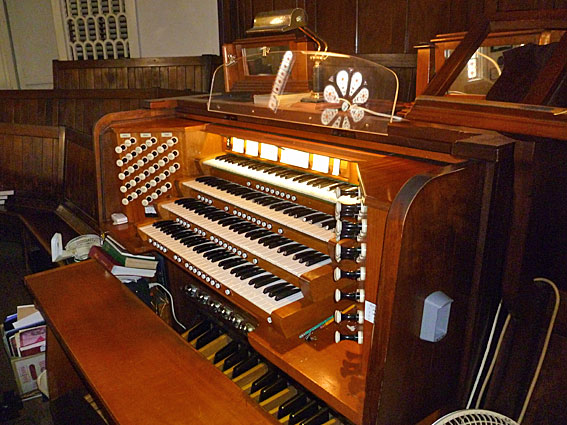
Console enlarged to 4 manuals
[Photograph by David Vann (April 2014)]
The current specification is:
| GREAT Open Diapason [Ten.C] Open Diapason No 1 Open Diapason No 2 Hohl Flute Dulciana Principal Harmonic Flute Fifteenth Mixture Trumpet SWELL Contra Violone Open Diapason Rohr Flute Salicional Vox Celeste [Ten.C] Geigen Principal Cymbal Bassoon Horn Oboe CHOIR Stopped Diapason Viola de Gamba Dulciana Flauto Traverso Clarinet SOLO (floating before 2013) Lieblich Gedackt Vox Angelica [Ten.C] Concert Flute Piccolo Vox Humana Orchestral Oboe Corno di Bassetto Great Trumpet PEDAL Open Diapason Bourdon Violone Principal Bass Flute Cello Fifteenth Flautino Contra-Trombone Trombone COUPLERS Great to Pedal Swell to Pedal Choir to Pedal Solo to Pedal Swell to Great Swell to Choir Choir to Great Solo to Great Solo to Swell Solo to Choir Great Super Octave Swell Super Octave Swell Sub Octave Swell Unison Off Choir Super Octave Choir Sub Octave Choir Unison Off Solo Super Octave Solo Sub Octave Solo Unison Off |
16 8 8 8 8 4 4 2 IV 8 16 8 8 8 8 4 III 16 8 8 8 8 8 4 8 8 8 4 2 8 8 8 8 16 16 16 8 8 8 4 4 32 16 |
A A B C E F? F? B C D E A D E A D C C |
[1989] [1989] [1989] [2000] [1924] [2013; on Solo 1989] [2013] [1989] [c.1962] [c.1962] [c.1962] [c.1962] [1970] [c.1962] [1970] [2013] [1924] [1989] [1989] [1989] [1989] [2003] [bottom octave electronic] [2003] |
Swell tremulant
Choir tremulant
Solo tremulant
Detached drawstop console (4 manuals from 2013)
Electro-pneumatic action
Compass: 61/32
8 thumb pistons to Swell Organ
8 thumb pistons to Great Organ
8 thumb pistons to Choir Organ
8 thumb pistons to Solo Organ
8 toe pistons to Pedal Organ
3 general pistons
1 great to pedal thumb piston (reversible)
1 full-organ toe piston
All pistons combined
10-channel combination capture system.30
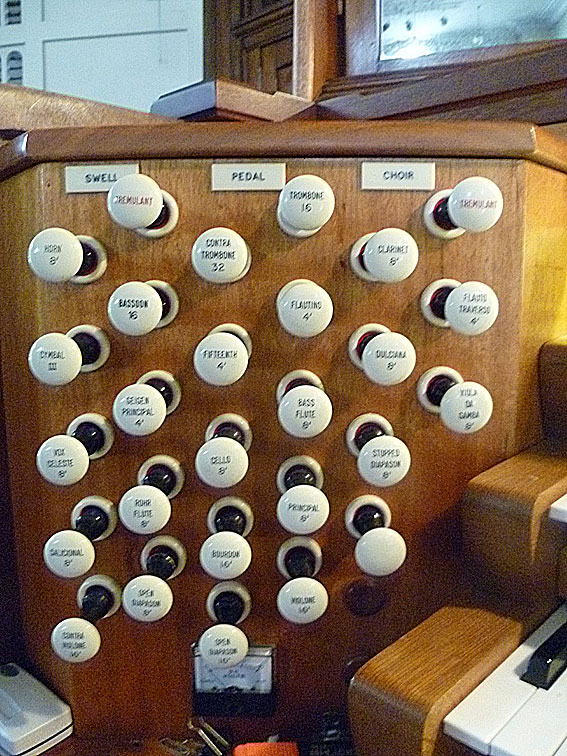
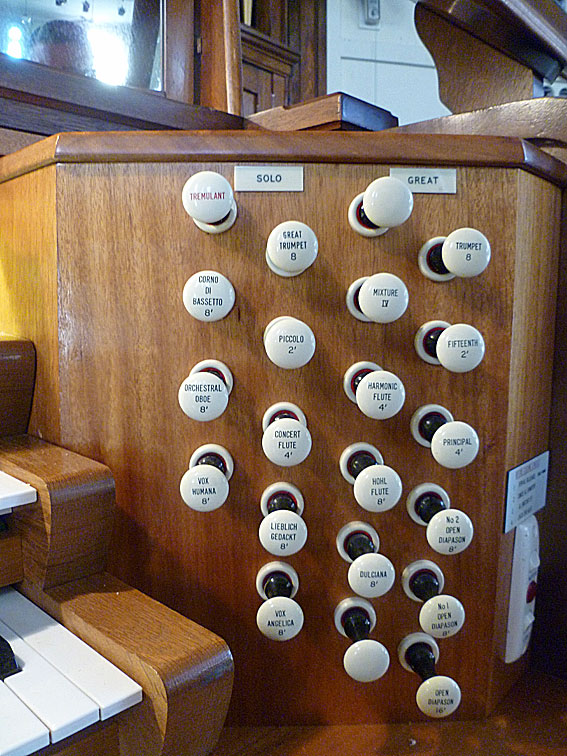
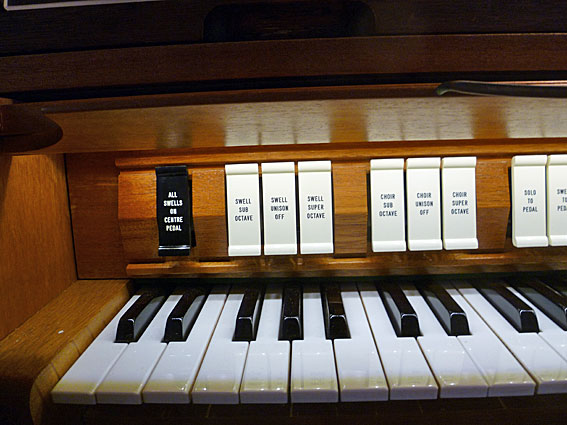
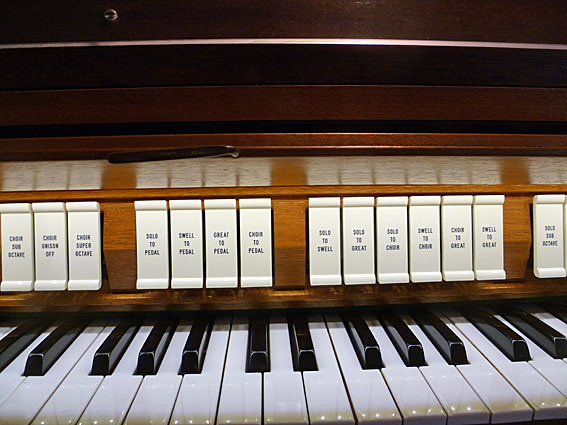
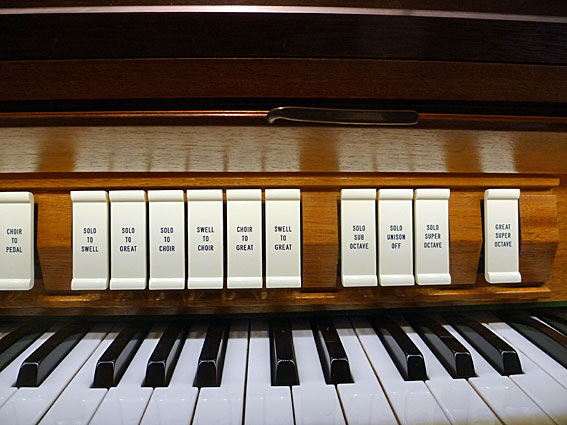
Console details of the enlarged organ
[Photographs by David Vann (May 2014)]
________________________________________________________________________
1 John E. White, A Fellowship of Service: A History of the Baptist Union of Queensland, 1877-1977 (Brisbane: Baptist Union of Queensland, c.1977), pp. 22-25; Richard Bardon, The Centenary History of The Presbyterian Church of Queensland (Brisbane: W.R. Smith & Paterson, 1949), p. 19.
2 E.J.T. Barton, ed. Jubilee History of Queensland: a Record of Political, Industrial, and Social Development, from the Landing of the First Explorers to the Close of 1909 (Brisbane: H. J. Diddams, [c.1910]), p. 144.
3 White, op. cit., pp. 26-27; City Tabernacle Baptist Church, Brisbane, Queensland. Centenary: 135th Church Anniversary and Centenary of the Opening of the Tabernacle (Enoggera: Crusade Press, 1990), p. 4.
4 "Diary of Events" for 30 October 1881, in Pugh's Queensland Almanac . . . for 1882; Diary of Events" for 2 August 1888, in Pugh's Queensland Almanac . . . for 1889.
5 The Brisbane Courier (6 October 1890), p. 5; "Diary of Events" for 5 October 1890 in Pugh's Queensland Almanac . . . for 1891.
6 Donald Watson & Judith McKay, Queensland Architects of the 19th Century: A Biographical Dictionary (Brisbane: Queensland Museum, 1994), pp. 72-73, 78.
7 White, op. cit., p. 25; City Tabernacle Baptist Church . . .135th Church Anniversary (1990), op. cit., pp. 3, 5-6.
8 White, op. cit., pp. 26-27; "Diary of Events" for 12 October 1890, in Pugh's Queensland Almanac . . . for 1891.
9 Hill & Son Shop Book 2 (1875-84), p. 45 (British Organ Archive, Birmingham)
10 Hill & Son Shop Book 2 (1875-84), pp. 29, 37 (British Organ Archive, Birmingham)
11 Witnessing for Christ throughout a Century 1855-1955: The Story of the City Tabernacle Baptist Church, Wickham Terrace, Brisbane, Qld (Programme of Centenary Celebrations, 1955).
12 The Daily Mail (Brisbane, March 10, 1906), p. 9.
13 City Tabernacle Baptist Church . . .135th Church Anniversary (1990), op. cit., p. 8.
14 Graeme Rushworth, Historic Organs of New South Wales: The Instruments, Their Makers and Players, 1791-1940 (Sydney: Hale & Iremonger, 1988), p. 425.
15 Bill Hughes, The Centenary of the City Tabernacle Baptist Church Organ, 1915-2015 (Brisbane: City Tabernacle Baptist Church, 2015), pp. 5-6.
16 The Brisbane Courier (14 February 1914), p. 5.
17 The Brisbane Courier (27 January 1915), p. 9; The Brisbane Courier (26 January 1915), p. 8; Opening Recital Programme, including specification, cited by G. Cox, c.1974.
18 The Brisbane Courier (2 February 1915), p. 6.
19 The Brisbane Courier (5 May 1924), p. 9; Whitehouse Bros Ledger (1922-1940), p. 115.
20 Collected Organ Specifications of Bernie Brohan (c.1952), with additional details from Notebooks of Edward R. Salisbury (n.d.).
21 Whitehouse Bros Ledger (1922-1940), pp. 206, 324, 491; Whitehouse Bros Ledger (1940-1954), pp. 490, 262; The Courier-Mail (2 June 1954), p. 8.
22 Dates and details provided by Kevin M. Whitehouse (c.1972).
23 Specification noted by G. Cox, 1972.
24 Personal communication to G. Cox from H.W. Jarrott (c.1990); Darcy Gough, 'The City Tabernacle Organs, Brisbane,' The Organ Voice, vol. 19, no. 2 (June 1992), pp. 28-33.
25 The Organ Voice, vol. 26, no. 4 (December 2000), p. 25; The Sydney Organ Journal, vol. 32, no. 4 (Spring 2001), p. 39.
26 The Sydney Organ Journal, vol. 34, no. 4 (Spring 2003), p. 41.
27 The Organ Voice, vol. 31, no. 1 (March 2004), p. 22; The Sydney Organ Journal, vol. 35, no. 2 (Autumn 2004), p. 36.
28 The Sydney Organ Journal, vol. 42, no. 1 (Summer 2010-11), p. 66.
29 Ian D. Brown & Associates, Newsletter (December 2013); 'News from the Organ Builders,' Plenum: the journal of the Hunter District Organ Music Society, vol. 35, no. 4 (December 2013), p. 16.
30 Gough, op. cit., pp. 32-33; subsequent changes as noted above and from console photographs by David Vann (2014).